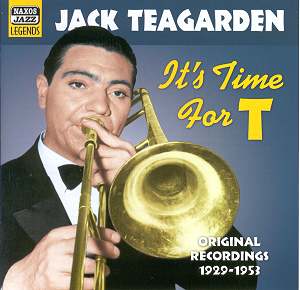The world is not short of
Teagarden retrospectives – this is in fact
the second in Naxos Jazz Legends’ own series
– but they’re always welcome. If you’ve not
yet racked up the Charleston Chasers sides
or the Big Eight, a stellar meeting with Rex
Stewart, Barney Bigard and Ben Webster in
the front line, you might want to give the
track list a look-over.
If you do you’ll find that
amidst the expect Ben Pollack and Teagarden
and His Band sides you will encounter four
Standard Transcription 78s recorded in Los
Angeles from 1941-45. These were with his
Orchestra, a largely anonymous studio band
without any other soloists of distinction.
His glorious solo in Nobody Knows The
Trouble I've Seen is all too brief
and the tune Glass Blues – credited
to "composer unknown" – will be
better known as The Mooche; a fine
way to avoid royalty payments, despite the
nod toward Ellingtonia.
One of the advantages of
a single disc compilation is to trace Teagarden’s
lineage from the early Jimmy Harrison influence
(noticeable in Dinah) to the effortless
lyricist of the later period. Admirers of
his meeting with Louis Armstrong and Earl
Hines in Knockin’ A Jug will also recognise
his solo in the 1929 Makin’ Friends
– stop time chorus, a touch of Armstrong-influenced
scat and bluesy cornet from Jimmy McPartland
(who once tapped me on the shoulder to let
him through at the 100 Club in London whilst
carrying Bix Beiderbecke’s old chair; "’Scuse
me, son" he said as he passed, a magical
figure reeking of speakeasies and rapacious
brass duels).
Listen out for the Fletcher
Henderson influence on the reed section’s
chorus in Beale Street Blues and for
Joe Venuti’s swing on After You’ve Gone
– and not forgetting Jess Stacy’s evocative
Teddy Wilson-like limpidity on Diane. Lovers
of Pee Wee Russell can admire his Picasso-esque
obbligato to Teagarden’s vocal on Serenade
To A Shylock. The depth of the sidemen
is one of the most obvious pleasures throughout.
Recording quality is good;
a few of the earlier sides are very slightly
noisy but that’s of little account. If you’ve
yet to meet some of these tracks – you can
hardly have avoided all of them unless you’re
mired in specialism of the most arcane kind
- then volume two in Naxos’s series is certainly
worth a listen.
Jonathan Woolf
